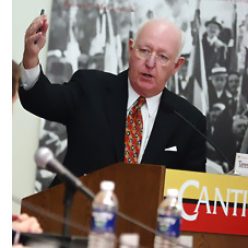No more Predictions.
That is my pledge barely halfway through this most unpredictable election year. I have been so consistently wrong in this space and elsewhere about Donald Trump, Jeb Bush and even Bernie Sanders that it is time to swear off predictions for the balance of the 2016 presidential circus.
Observations, OK; comments, maybe. But predictions? A waste of your time and mine.
Six months ago, I wrote confidently that Donald Trump’s act would get old, that the public would tire of his bluster and bragging, that his lies and exaggerations would trip him up and — get this — that the media would finally stop giving him millions of dollars worth of free airtime and exposure and start doing its job.
As recently as last month, I observed that “some of the air has begun to leak out of the Trump bubble.”
Then came his five-state sweep, including Maryland, on April 26, and, last Tuesday, Indiana. That alone should revoke my self-issued prognostication license.
I have also looked largely in vain for the tough questioning and balanced coverage of the Trump phenomenon that I predicted surely would come from major news organizations. Instead, the cable news channels have continued to cover his raucous rallies wall-to-wall. Trump is news – I get that – but there is such a thing as too much.
The camera stays on his appearances as he insults the audience’s intelligence with outlandish claims about how he will “make America great again,” just by being president and by being Donald Trump, master deal-maker.
“Morning Joe” and other talk shows are shameless in the free airtime they lavish on The Donald, as they call him. The day after Trump’s five-state sweep, Joe Scarborough was positively giddy when Trump called in by phone, kidding the candidate about how it was time to “act presidential.”
Meanwhile, while host and guest continued stroking each other and Mika Brzezinski giggled, MSNBC’s ratings jumped, and the dollars kept rolling in. Ditto on Fox and CNN.
To be sure, there have been some tough, probing stories in mainstream newspapers about Trump’s shady promotions like the Trump University, Trump Steaks and Trump Vodka, all discontinued or in court. Others have shed light on his casino failures in Atlantic City and his long history of unfulfilled promises.
On CNN, host Chris Cuomo repeatedly challenged Trump to explain how he would build his famous wall and make Mexico pay for it, bar Muslims from entering the country and bring China to heel in a new trade war by asking simply, again and again: “How?” Cuomo got no answers, of course, as Trump talked over him, but the audience got the point.
I also assumed and predicted that Jeb Bush would emerge as the leading candidate for the GOP nomination once Trump faded.
I clung to that notion through February, until it was clear that Jeb! was boring the voters to distraction and had burned through his $130 million to no avail.
I did get one thing right: I predicted that Ted Cruz would prove too hard-edged and sinister to expand beyond his evangelical base. His selection of Carly Fiorina as a running mate enabled her to become the first candidate to lose the same election twice.
I underestimated Bernie Sanders from the beginning. I misread the depth of despair among younger voters at politics-as-usual and their willingness to vote for a 74-year-old self-described democratic socialist as a change agent. I never thought he would become the nominee, and still don’t, but I underestimated the degree to which he would influence the debate and move the Democratic Party to the left.
Now, in keeping with my pledge, I’ll make no predictions about the Trump-Clinton face-off in the general election. Clinton is currently leading in the national polls, but November is a long way off. I’ll simply recall H.L. Mencken’s famous quote: “No one ever went broke underestimating the intelligence of the American public.”
Mencken was talking about the rise of tabloid newspapers, but his acerbic view could be applied more broadly today.
